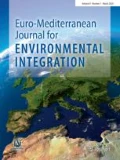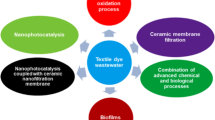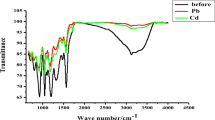Abstract
In this study, the morphology, chemical composition, and electrochemical characteristics of three carbon-based and three noble metal/alloy electrodes were evaluated. Measurement of free chlorine production was carried out using iodine–starch method. Measurement of hypochlorite production was performed using N,N-diethyl-p-phenylenediamine (DPD). The electro-catalytic activity of the electrodes was characterized using cyclic voltammetry (CV). Among the noble metals, the gold–palladium alloy electrode showed the best catalytic performance. Among the carbon-based electrodes, TiC showed the best catalytic performance. Scanning electron microscopy (SEM) images before and after reaction confirms the stability of the TiC electrode, proving its potential for long-term use. The chemical structure of the electrodes was characterized using X-ray photoelectron spectroscopy (XPS) and this showed that carbon electrodes present a trace graphene oxide structure (sp3 orbitals C–OH/C–O). Moreover, the modification of porous carbon by vacuum-assisted TiO2 impregnation indicates that the electronic state of TiC did not change due to impregnation with TiO2. In summary, the TiC carbon-based electrode shows high stability and potential for long use.










Similar content being viewed by others
References
Ashworth V and Booker CJ (1986) Cathodic protection: theory and practice. Prentice hall professional, technical reference. ISBN: 0470202831
Bergmann MEH, Koparal AS (2005) Studies on electrochemical disinfectant production using anodes containing RuO2. J Appl Electrochem 35:1321. https://doi.org/10.1007/s10800-005-9064-0
Casson W, Bess W Jr (2003) Conversion to on-site sodium hypochlorite generation. Lewis Publishers, New York
EPA (2011) Water treatment manual: disinfection, pp 200, ISBN: 978-184095-421-0
Fryda M, Dietz A, Herrmann D, Hampel A, Schäfer L, Klages CP (2000) Wastewater treatment with diamond electrodes. Electrochem Soc Proc 99–32:2000
Göpel W, Anderson JA, Frankel D, Jaehnig M, Phillips K, Schäfer JA, Rocker G (1984) Surface defects of TiO2 (110): a combined XPS, XAES and ELS study. Surf Sci 139(2–3):333–346
Hanaor DAH, Sorrell CC (2011) Review of the anatase to rutile phase transformation. J Mater Sci 46:855–874. https://doi.org/10.1007/s10853-010-5113-0
Hoffeditz WL, Katz MJ, Deria P, Martinson AB, Pellin MJ, Farha OK, Hupp JT (2014) High-surface-area architectures for improved charge transfer kinetics at the dark electrode in dye-sensitized solar cells. ACS Appl Mater Interfaces 6:8646–8650. https://doi.org/10.1021/am501455b
Joonseon J, Kim C, Yoon J (2009) The effect of electrode material on the generation of oxidants and microbial inactivation in the electrochemical disinfection process. Water Res 43:895–901
Kelly WR, Panno SV, Hackley K (2012) The sources, distribution and trends of chloride in the waters of Illinois. Ill. Bulletin N-74. Champaign, Illinois State Water Survey, p 59
Kitazono Y, Ihara I, Yoshida G, Toyoda K, Umestsu K (2012) Selective degradation of tetracycline antibiotics present in raw milk by electrochemical method. J Hazard Mater 243:112–116
Kraft A (2008) Electrochemical water disinfection: a short review. Platin Met Rev 52(3):177–185
Martinez-Huitle CA, Brillas E (2008) Electro-chemical alternatives for drinking water disinfection. Angew Chem Int Ed 47:1998–2005
Mashburn SL, Sughru MP (2004) Chloride in groundwater and surface water in the vicinity of selected surface water sampling sites of the beneficial use monitoring program of Oklahoma 2003. US geological survey scientific investigation report. US Geological Survey, Virginia, p 41
Metcalf E (2003) Wastewater engineering, 3rd edn. Irwin/McGraw-Hill, New York
Mullaney JR, Lorenz DL, Arntson AD (2009) Chloride in groundwater and surface water in areas underlain by the glacial aquifer system, northern United States. US geological survey scientific investigation report. US Geological Survey, Virginia, p 41
Nakajima N, Nakano T, Harada F, Taniguchi H, Yokoyama I, Hirose J, Daikoku E, Sano K (2004) Evaluation of disinfective potential of reactivated free chlorine in pooled tap water by electrolysis. J Microbiol Methods 57(2):163–173
Pulido ME (2005) Evaluation of an electro-disinfection technology as an alternative to chlorination of municipal wastewater effluents. Theses and dissertations, University of New Orleans p309
Radjenovic J, Sedlak DL (2015) Challenges and opportunities for electrochemical process as next generation technologies for the treatment of contaminated water. Environ Sci Technol 49:11292–11302
Rajeshwar K, Ibanez J (1997) Environmental electrochemistry: fundamentals and applications in pollution abatement. Academic Press, San Diego
Sato Y, Kawaguchi T (2014) Patterning of alkylamine molecules on highly oriented pyrolytic graphite surfaces via deep UV light irradiation. Chem Lett 43:1542–1544. https://doi.org/10.1246/cl.140538
Sohn KS, Oh SJ, Kim EJ, Gim JM, Kim NS, Kim YS, Kim JW (2013) A unified potentiostat for electrochemical glucose sensors. Trans Electr Electron Mater 14(5):p273–p277. https://doi.org/10.4313/TEEM.2013.14.5.273
Sreeprasad TS, Vikas B (2013) How do the electrical properties of graphene change with its functionalization? N3, 341–350. Wiley VCH Verlag GmbH & Co. KGaA, Weinheim
Acknowledgements
We acknowledge the Global Station for Food, Land and Water Resources (GSF), a project of Global Institution for Collaborative Research and Education at Hokkaido University for support and partial funding of this research.
Author information
Authors and Affiliations
Corresponding author
Ethics declarations
Conflict of interest
On behalf of all authors, the corresponding author states that there are no conflicts of interest to declare.
Additional information
This paper has been selected from the 1st Euro-Mediterranean Conference for Environmental Integration, Tunisia 2017.
Rights and permissions
About this article
Cite this article
Guizani, M., Yajima, K., Kawaguchi, T. et al. Evaluation of in situ water electrochemical disinfection using novel carbon-based and noble metal electrodes. Euro-Mediterr J Environ Integr 3, 31 (2018). https://doi.org/10.1007/s41207-018-0075-8
Received:
Accepted:
Published:
DOI: https://doi.org/10.1007/s41207-018-0075-8




